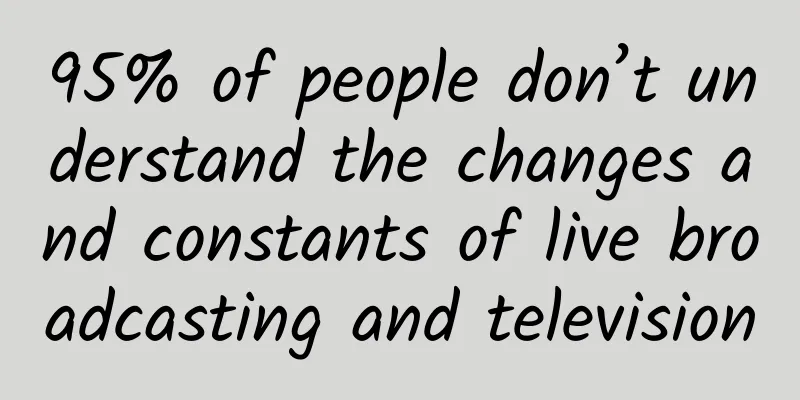95% of people don’t understand the changes and constants of live broadcasting and television

|
Among the Internet keywords in 2016, "live broadcast" undoubtedly ranks at the top. Since the middle of the year, live broadcast has replaced short videos as a new large traffic entrance. The number of people participating in live broadcasts has also gradually expanded from Internet celebrities to the whole people, and the content has also developed from the initial single entertainment to a more diversified direction. 95% of people don’t understand the changes and constants of live broadcasting and television Live broadcasts are generally considered to be highly interactive and instantaneous. People can feel a sense of presence far beyond the traditional TV experience in the interaction of sending gifts and posting comments. Indeed, traditional TV communication is a typical representative of one-way communication. It can only be barely labeled as interactive when it comes to programs such as "TV shopping" and "talent voting". However, how different is it to watch a popular live broadcast and watch TV? People think that live broadcasts are more interactive because you can leave comments and feel your presence. In a popular live broadcast room, the interactive feedback of swiping comments is actually very weak. Because you are still one in a hundred thousand or even one in a million of the audience, your speech will not stay on the screen for more than one second, and the host will not respond to you. At this time, the value you feel from the platform is actually similar to watching TV. But if you swipe a rocket or a diamond for the host, the host will definitely pick your name out to express gratitude. Brushing comments is only a one-way behavior. If you spend money for the host, it becomes an interaction. The difference here is whether you spend money. The similarity between live broadcast and TV is that as a non-paying viewer, your sense of value when watching popular live broadcasts is still very weak, which is no different from watching TV. This is one of the misunderstandings that live broadcast platforms are more interactive than TV. But the real difference between live broadcast platforms and TV is that you can pay to add in. Paying to add in is something that TV cannot do. Now let’s talk about the second topic. Let’s do a small survey: When do you think the live broadcast industry is most popular? Many audience members answered that it was from 10pm to 12pm, and quite a few answered that it was the midnight show after 12pm. I also thought it was these two time slots at first. When my friend asked me this question, my initial answer was after 9 o'clock, or until 11 or 12 o'clock. But the actual situation is not like this. Although the current live broadcast industry is very similar to the "Warring States Period" - there are many live broadcast platforms and columns, but in fact, from the data of major platforms, you will find a particularly obvious phenomenon: the three most golden time periods are 7 to 9 pm, 12 noon, and 9 am. All of us present here are in Beijing, and the normal working hours are 6 or 7 o'clock. Even if we don't work overtime, we have a meal after work, and there is a traffic jam on the way home. It's 9 o'clock when we get home. It's easy for us to judge live broadcasting from the perspective of our own lives. Many people present here are probably not from Beijing. Imagine what your parents and classmates’ living habits are like when you return to your hometown? They get off work at 5:30 in the afternoon, and it only takes ten minutes to get home. They eat until about 7 o’clock in the evening, and then what do they do? They are in the living room, turn on the TV, and either watch the news or start watching TV series. According to the data from major live broadcast platforms, the time period with the highest user activity is not late at night but from 7 to 9 o’clock in the evening. This can't help but remind people of the saying of "8 o'clock prime time" on TV stations. Whether you analyze and judge from the living habits of people in second-tier and lower-tier cities, or from the data of major live broadcast platforms, you will find a particularly obvious feature - it is a new technology, but live broadcasting is not new in essence. What has changed is the way people look at the screen - people's attention and what people spend their time on every day. This is the biggest change in live broadcasting. What remains unchanged is that it is the same as TV. It is used to "kill time" for people. The equipment people use to "watch TV" - from large screens to small screens - has changed, but what remains unchanged is that people's habit of "killing time" after get off work has not changed. The habit of killing time has not changed, so it is necessary to create a variety of content to fill it in for the audience. In the past, people would turn on the TV after get off work and eat dinner to watch news, sports events, TV series or talent shows. In the era of mobile Internet, the carrier of this action has changed from TV to mobile phone. But people's behavior patterns have not changed in essence. The change from large screens to small screens has created opportunities for content producers, especially professional content producers. Better content is always more competitive. This can be seen from the current ecology of short videos and web dramas. Whether it is WeChat public accounts such as "Yi Tiao" and "Er Geng" that produce short videos, or popular videos such as "Qi Pa Shuo" and "Diao Si Nan Ren" on video websites, they are all very professional media people producing high-quality video content. The development of content on different platforms always goes through a similar process. The content of Weibo and WeChat public accounts was initially provided by early adopters, and many ordinary users generated content through UGC. Some early platform users gradually accumulated a group of their own fans through content production, and thus had a certain voice. After that, these accounts can start to realize their own value, such as accepting advertisements and publishing soft articles. Looking back at the WeChat public accounts in the past two or three years, we can find an obvious trend: the elites of traditional media are entering in large numbers and in an organized manner. The saying "starting a business means opening a public account" might have been looked down upon by many media elites a few years ago, but not now. Currently, the top public accounts in various vertical fields on WeChat are usually run by traditional media elites in an organized and organized manner. Both "Serious Gossip" and "Mimeng" were founded and developed by media people. The development of the content ecology of live broadcast is also likely to follow this rule. Now the platform is more about entertainment content such as Internet celebrities and shows. There are even some videos on Kuaishou that have amazing views of "catching crabs" and "catching pythons". This may be because the industry is still in the stage where "losers can make a comeback". This is an opportunity for content producers of any background, and more and more traditional media elites are migrating to the video field. They still have great opportunities for professional content. Social and news are the future of live streaming Yixia Technology recently announced a $500 million financing, and its current market value is $3 billion. It is considered the strongest player in China in this field. Redpoint Ventures invested in Yixia Technology five years ago and was the earliest institutional investor. I think Redpoint has a lot to say in this field. A month ago, Redpoint partner Wu Feng talked to me about his views on live streaming platforms. In his opinion, "live streaming" itself is just a technology, but for live streaming platforms to be able to retain and maintain their vitality, they need a key element, that is, social networking. Social networking can truly precipitate user relationships on the platform, such as Facebook abroad and WeChat, Weibo, Momo, etc. in China. The live broadcast platforms derived from these platforms have natural social attributes. The content on the platform comes from the users' friends. Users are very sticky to the information from their friends, just like Moments. Most people's Moments have no news value, but users will definitely read them. These contents may be a selfie, lunch at noon today, or PR you do for your company, showing overtime, etc. Platforms like Momo and Miaopai, which is linked to Weibo, may have greater opportunities in the future. By the way, Momo performed very well in the latest quarter's financial report, mainly because of the live broadcast business. Another direction of live broadcast is news, which covers a wide range of news, including world news, sports news, entertainment news and even online dramas. As mentioned before, people need a variety of news and programs to help them kill time, and mobile phones are gradually taking over this trend. The number of viewers and viewing time of traditional TV will continue to decline, and these lost people and time are migrating to mobile phones in large quantities. Those advertisements originally placed on TV will also be migrated to mobile phones. At this time, the model of traditional TV stations may appear on live broadcast platforms. As a winner of Toutiao's Qingyun Plan and Baijiahao's Bai+ Plan, the 2019 Baidu Digital Author of the Year, the Baijiahao's Most Popular Author in the Technology Field, the 2019 Sogou Technology and Culture Author, and the 2021 Baijiahao Quarterly Influential Creator, he has won many awards, including the 2013 Sohu Best Industry Media Person, the 2015 China New Media Entrepreneurship Competition Beijing Third Place, the 2015 Guangmang Experience Award, the 2015 China New Media Entrepreneurship Competition Finals Third Place, and the 2018 Baidu Dynamic Annual Powerful Celebrity. |
<<: American pickup trucks target the Chinese market, with wealthy customers as their target users
>>: US court postpones Volkswagen 3.0L diesel trial
Recommend
Tips for placing Tencent ads in the automotive industry
1. Industry prospects and current situation With ...
Operations are not based on intuition, but are driven by data.
Many college students who are about to graduate w...
Illustrations | Home and business gas safety knowledge cards
Gas leaks can easily lead to explosions How to us...
Sony to slash staff: Will halve smartphone business staff by March next year
Another tech giant is laying off employees! Accor...
Event promotion: A collection of 54 event cases for the 2019 Spring Festival!
During the Spring Festival, major Internet platfo...
Big Dog is here "Small Game Promotion Practical Course" takes you to build a game promotion and monetization account
No. 1 on the Talent List, single video revenue of...
A comprehensive analysis of "Tik Tok" short videos, the trend of the new era?
In this fast-paced, information-based society, yo...
A complete analysis of the Toutiao search account setup and delivery ideas
As a new search platform launched this year, Tout...
Brand Marketing Promotion | Where will the “viral” spread of vulgar marketing lead to?
Introduction: I don’t know when it started, but t...
20 thoughts on marketing, copywriting, and new media!
1. There is a very famous marginal effect in econ...
Why doesn’t Pinduoduo have a shopping cart?
In October 2019, Pinduoduo's market value sur...
Bloomberg: Chinese-made cars will account for nearly 10% of South Africa's total auto sales in 2024
Bloomberg News reported that Trump wants to shut ...
Taobao live streaming methodology!
Brands’ self-broadcasting on Tmall presents both ...
Various styles of gesture sliding Cell
Source code introduction MGSwipeTableCell is a su...
Tencent's top 10 open source projects for WeChat and mobile development
Tencent has open-sourced many very valuable proje...









